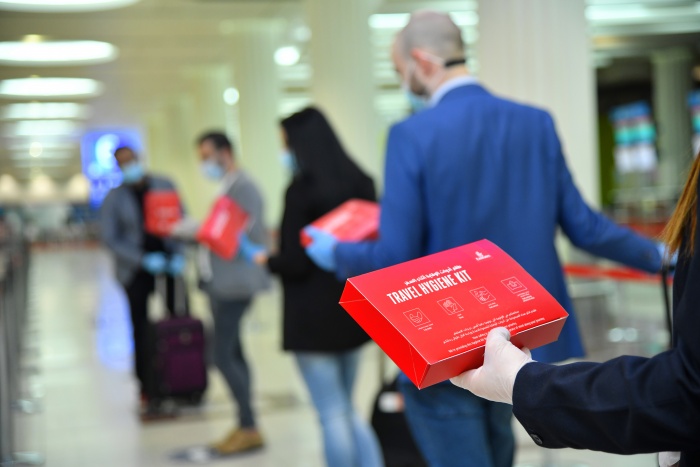
Emirates unveils new Covid-19 protections as flights resume
Emirates has unveiled multi-faceted measures for employee and customer care.
The new measures took effect earlier, with the resumption of regularly scheduled passenger flights to nine destinations.
As well as offering flights between Dubai and Heathrow, the airline is providing connections for customers travelling between the UK and Australia – with the new safety measures designed to give maximum confidence to passengers.
“Emirates is implementing a comprehensive set of measures at every step of the traveller’s journey, to enhance the sanitisation of all touchpoints, and ensure the health and safety of our customers and employees.
“The risk of catching an infection on an aircraft is already very low, but we have spared no effort in reviewing and redesigning every step, from check-in to disembarkation,” said Adel Al Redha, Emirates chief operating officer.
“Every measure implemented is an additional reduction in risk, and taken altogether, our aim is really to make flying as safe as possible.
“We are working with all the stakeholders in Dubai - including the airport, immigration, health and aviation authorities to implement such measures, and we will continue to review and consult expert advice for any development and changes.
“We are all aware that we have to adapt to different practices during this pandemic in our day to day activities.
ADVERTISEMENT
“All these measures, in combination with the proactive pandemic management strategies that the UAE has taken, show the seriousness with which we are taking the health and safety of our local and global communities and will give confidence to the public,” he added.
Emirates has introduced complimentary hygiene kits to be given to every passenger upon check in at Dubai International Airport and on flights to Dubai.
Gloves and masks are mandatory for all customers and employees at the airport in Dubai, while only masks are mandated on Emirates flights.
On arrival at the airport, thermal scanners at various areas monitor the temperatures of all passengers and employees.
Physical distancing indicators have been placed on the ground and at waiting areas to help travellers maintain the necessary distance at check-in, immigration, boarding and transfer areas.
Customers travelling through Dubai International Airport and transferring onto another flight, will go through thermal screening upon disembarkation.
Transfer desks at the airport have also been installed with protective barriers as a precautionary measure.
Airport staff, dressed in personal protective equipment will direct customers from a safe distance for extra assistance.
The boarding sequence has been staggered and passengers board by row, from the last row to the first, in small numbers. The waiting area has also been modified to ensure all customers observe social distancing.
Emirates boarding agents, dressed in personal protective equipment, will facilitate the boarding sequence.
The boarding gates are deep cleaned and disinfected after the boarding of every flight.
Cabin baggage have to be checked-in, and customers can only bring essential items such as a laptop, handbag, briefcase or baby items on board.
Customers are reminded to bring pens to fill out health declaration forms required for some destinations.
Emirates’ modern aircraft cabins have been fitted with advanced HEPA air filters which remove 99.97 per cent of viruses and eliminate dust, allergens and germs from cabin air for a healthier and safer on-board environment.
After its journey and on landing in Dubai, each aircraft will go through enhanced cleaning and disinfection processes to ensure safety and proper sanitation.
To safeguard its employees, Emirates’ flight and cabin crew are provided with cars for pick up and drop off at their home at the beginning and end of their duty.
Operating crew check in for their rostered flights in a dedicated crew airport facility before being transported to the aircraft.
Layovers in destination cities have been reduced where possible and on long-haul flights, where layovers are necessary, crew are put up in individual rooms in hotels.

